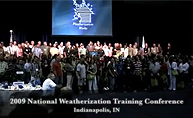The Weatherization Assistance Program enables low-income families to permanently reduce their energy bills by making their homes more energy efficient. During the last 32 years, the U.S. Department of Energy's (DOE) Weatherization Assistance Program has provided weatherization services to more than 6.2 million low-income families.

State Funding from the Weatherization Assistance Program under the 2009 Recovery Act 
Find the award for each state and the amount of funding allocated to date.
Some of the following documents are available as Adobe Acrobat PDFs. Download Adobe Reader.
Impact of Davis-Bacon Requirements of the 2009 Recovery Act on Weatherization
-
Notice to weatherization agencies about the Davis-Bacon provisions of the 2009 Recovery Act from DOE Weatherization and Intergovernmental Program Manager Gil Sperling; July 10, 2009 (PDF 22 KB)
-
Letter to weatherization agencies about wage rates from Energy Secretary Stephen Chu and Labor Secretary Hilda Solis; July 24, 2009 (PDF 967 KB)
-
Multifamily units memo; July 30, 2009 (PDF 92 KB)
-
Weatherization Assistance Program Notice 09-9 deals with the prevailing wage requirements in the 2009 Recovery Act; July 21, 2009 (PDF 64 KB).
-
Davis-Bacon Act Training
Link to audio file of June 30 training on Davis-Bacon Act requirements.

Video from the 2009 National Weatherization Conference 
Watch a video from the 2009 National Weatherization Training Conference to see and hear the conference attendees tell their stories.
By reducing the energy bills of low-income families instead of offering aid, weatherization reduces dependency and liberates these funds for spending on more pressing family issues. On average, weatherization reduces heating bills by 32% and overall energy bills by about $350 per year at current prices. This spending, in turn, spurs low-income communities toward job growth and economic development.
Oak Ridge National Laboratory gives technical support and evaluations.

The Weatherization Assistance Program Technical Assistance Center provides guidance for program operations and fosters community partnerships to advance weatherization.







